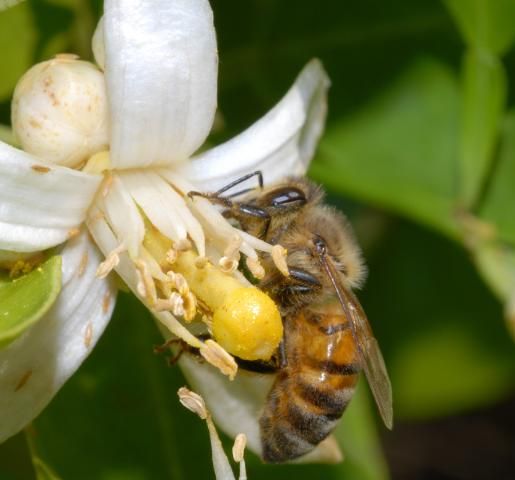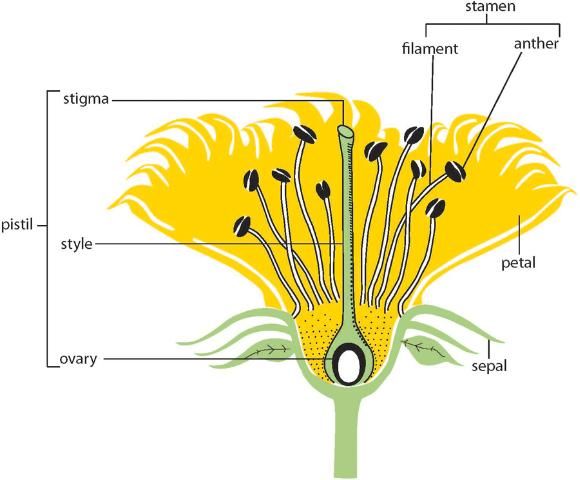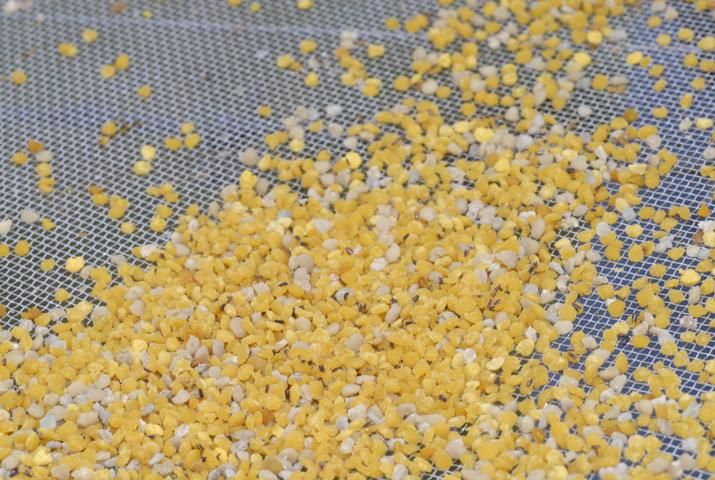The honey bee's basic nutritional requirements are similar to those of humans; namely, they need proteins (amino acids), carbohydrates (sugars), minerals, fats/lipids (fatty acids), vitamins, and water. In order to meet their nutritional requirements, honey bees collect nectar, pollen, and water.
Bees forage for water at almost any source close to their colonies. These sources include ponds, streams, leaky taps, the neighbor's pool, dog dishes, and bird baths. During hot weather, honey bees use water to cool the colony by fanning and evaporating water droplets inside the hive. Water may also provide essential minerals in addition to hydration.
Honey bees consume processed nectar (honey) and pollen (bee bread), both of which are provided by flowers (Figure 1). Nectar, which bees convert to honey, serves as the primary source of carbohydrates for the bees. It provides energy for flight, colony maintenance, and general daily activities. Without a source or surplus of carbohydrates, bees will perish within a few days. This is why it is important to make sure that colonies have sufficient honey stores during the winter months. Colonies can starve quickly! Nectar also is a source of various minerals, such as calcium, copper, potassium, magnesium, and sodium, but the presence and concentration of minerals in nectar varies by floral source.

Credit: Honey Bee Research and Extension Laboratory, University of Florida
Pollen Content
Pollen, in the form of bee bread, is the honey bee's main source of protein and it also provides fats/lipids, minerals, and vitamins. The protein that pollen provides is vital to brood production and the development of young bees. Pollen is the most nutritionally variable food source that honey bees use and typically is composed of the following: water (7%–16%); crude protein (6%–30%); ether extract (1%–14%); carbohydrates, including reducing sugars (19%–41%), non reducing sugars (0%–9%), and starch (0%–11%); lipids (5%); ash (1%–6%); and unknown (22%–36%). Pollen from different floral sources has different quantities of each component: all pollens are NOT equally nutritious to the bees.
The protein pollen provides is essential for hive growth, but the amount of crude protein available in pollen is highly variable among different pollens, ranging from 6%–30% of the total dry weight of the pollen. Protein is composed of amino acids, 10 of which have been identified as essential to honey bees. These include threonine, valine, methionine, isoleucine, leucine, phenylalanine, histidine, lysine, arginine, and tryptophan. The quantity and type of amino acids present in pollen varies by the floral source from which the pollen was collected.
Where is pollen produced?
Pollen is produced by the stamen, which is the male reproductive portion of a flower (Figure 2). Honey bees play an important role as pollinators as they transfer pollen from the stamen of a flower to the stigma (female part) of the same or different flowers. Sometimes the pollen only needs to be transferred to a stigma on the same flower or another flower on the same plant, but often the pollen must reach a different plant altogether. Consequently, a very intricate relationship has developed between plants and their pollinators, because both parties rely on one another for survival.

Credit: Entomology and Nematology Department, University of Florida
In terms of pollen production, plant species differ in the quantity and quality of pollen produced. Some plants may produce an abundance of pollen, but the pollen may be of poor quality, whereas others may produce very little but high quality pollen. Plants that are closely related (within the same genus) tend to have similar amounts of crude-protein available in their pollens. Plants with relatively high crude-protein values include canola (Brassica napus—23%) and almond (Prunus dulcis—26%), while plants with lower crude protein levels include raspberry/blackberry (Rubus spp.—19%), willow (Salix spp.—17%), sunflower (Helianthus annuus—16%), and pine (Pinus spp.—7%). It is important to note that there are several different methods used to analyze protein content in pollen, which, in turn, can yield different results. Consequently, one must use published protein levels in various pollens as a general guideline and not a definitive value.
Pollen Collection by Honey Bees
It has been observed that honey bee workers choose pollen based on the odor and physical configuration of the pollen grains rather than based on nutritive value. A typical-size honey bee colony (approximately 20,000 bees) collects about 57 kg of pollen per year. On average, 15%-30% of a colony's foragers are collecting pollen. A single bee can bring back a pollen load that weighs about 35% of the bee's body weight. Bees carry this pollen on their hind legs on specialized structures commonly called "pollen baskets," or corbicula (Figure 3).

Credit: Honey Bee Research and Extension Lab, Trevor Schleuter, University of Florida
Once pollen is brought back to the colony, the workers condition it by adding glandular secretions containing enzymes and acids that prevent harmful bacterial activity and prepare the pollen for long-term storage (Figure 4). Stored pollen often is called "bee bread." Bees also add beneficial microbes to the pollen and they produce enzymes that help the pollen release nutrients and amino acids. Bee bread is consumed by a colony relatively quickly and only stored for a couple of months if there is a surplus. A colony's annual requirement for pollen has been estimated to range from 15 to 55 kg.

Credit: Honey Bee Research and Extension Lab, C. M. Zettel Nalen, University of Florida
Bees require pollen for growth and development. Immature (larval) bees are fed a mixture of brood food and bee bread. Newly emerged bees consume bee bread so that their bodies can complete development. The amount of pollen required to rear a single worker larva has been estimated at 124–145 mg; this contains about 30 mg of protein. The minimum level of protein required for honey bees has been estimated to be between 20%–25% crude protein. Pollens with protein levels in this range are more useful to colonies and allow them to meet their protein requirements readily. A diet of high-protein pollen increases worker bee longevity, while brood rearing is reduced when supported by pollens low in protein.
Protein content is very important and is the most studied component of pollen, but little is known about the importance of other trace nutrients available in pollen to bees. The chemical analysis of the composition of pollen is complex and only a relatively few pollens have been investigated well. A good publication to review for pollen contents of many common plants is Fat Bees Skinny Bees (https://www.agrifutures.com.au/wp-content/uploads/publications/05-054.pdf). The authors of this manual include a list of pollen compositions from some common Australian plants. When reviewing the list, remember that plants within the same genus often have similar protein contents. This list can serve as a guideline for predicting protein content of pollen from similar plants in the United States.
Ensuring Colony Nutrition
What can a beekeeper do to ensure that the nutritional requirements of the colony are met? A beekeeper should make certain that plants in the area actually provide pollen. For example, bees do not forage on many ornamental plants, so not all blooming flowers are attractive to bees. Also, the volume of pollen produced by a plant is not correlated necessarily to a bee's use of that plant's pollen. Pine trees, for example, produce copious amounts of protein-poor pollen but typically are not visited by honey bees. Additionally, plants that produce large amounts of nectar do not always also provide pollen for bees. When considering the nutritional requirements of honey bees, it is important to remember "variety, variety, variety." No single pollen meets all the nutritional needs of a colony so a variety of pollens from different plant sources will help ensure that these needs are met. Just like humans, bees need well-rounded diets. When inspecting a honey bee colony, one should see frames with a rainbow of pollen colors (orange, yellow, red, white, green, etc.) present in the cells. Additionally, pollen quality is more important than quantity.
A beekeeper should be familiar with both nectar- and pollen-producing plants in their area. Also, a colony's requirements change depending on season, brood production, and the beekeeper's goals. If there is a lack of pollen, or a suspicion that the pollen available is of poor quality, a pollen substitute or supplement may be provided to the colony. Beekeepers should educate themselves about blooming plants in their area, and their colonies' seasonal needs. For a list of blooming plants in Florida by month and region, see: https://edis.ifas.ufl.edu/in848.